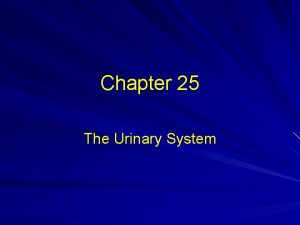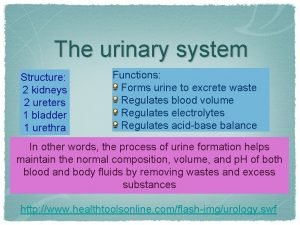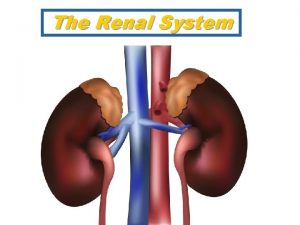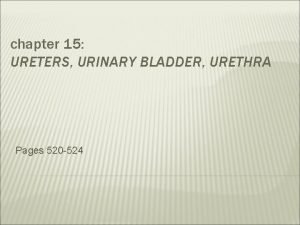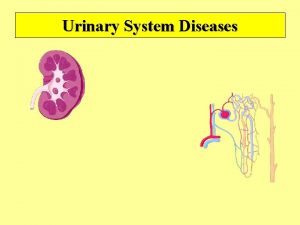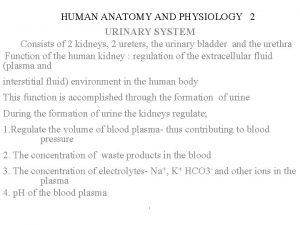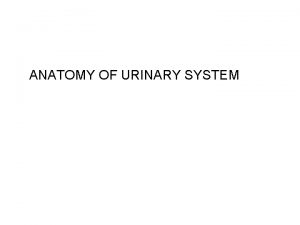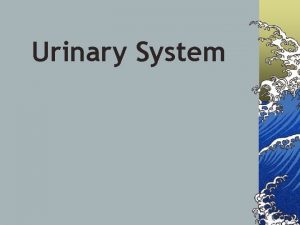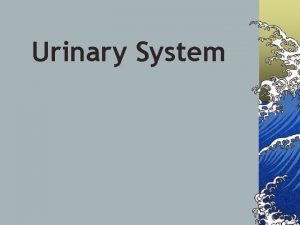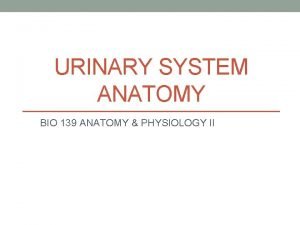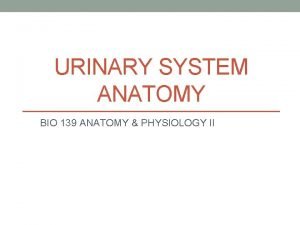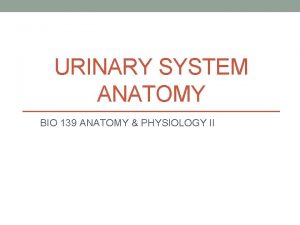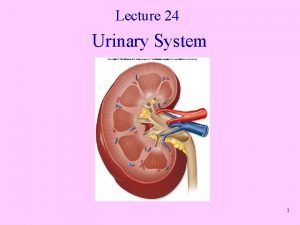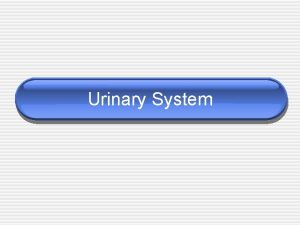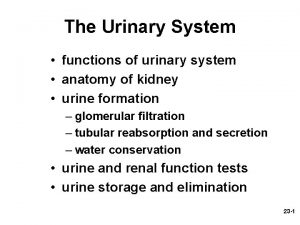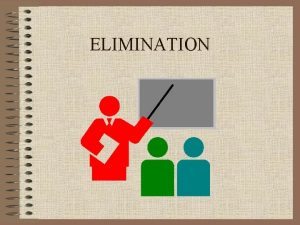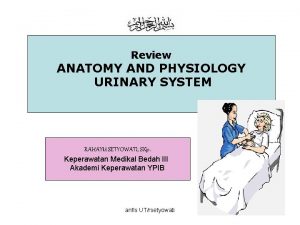REVIEW ANATOMY and PHYSIOLOGY The urinary system consists



















- Slides: 19

REVIEW ANATOMY and PHYSIOLOGY

The urinary system consists of: A. 2 kidneys B. 2 ureters (upper urinary tract) C. A urinary bladder D. A urethra (lower urinary tract)

Urine normally consists of 95% water Nitrogenous waste products or protein (urea, uric acid, creatinine) Excessive eletrolytes (Na, Ca, K, Ph) Bile pigments Hormones Metabolized drugs and toxins Micturition

A. The Kidneys Weighs about 120 -170 g, is 12 long, 6 cm wide, and 2. 5 cm thick Well protected by the ribs, muscles, Gerota’s fascia, perirenal fat and the renal capsule

Location of kidneys In the retroperitoneal space Function of kidneys: Urine formation Excretion of waste products Regulation of electrolytes Regulation of acid base balance Control of water balance Control BP Regulation of RBC production Synthesis of vitamin D to active form Secretion of prostaglandins


Nephrons: (a functional unit of kidney) responsible for urine formation Each nephrons consists of a glomerulus A glomerulus (filters the blood) Bowman’s capsule Proximal tubule Loop of Henle (reabsorb water and important nutrients in the filtrate) Distal tubule Collecting ducts



B. Ureters Urine flows into the ureter The ureters are narrow, muscular tubes 24 – 30 cm long Originate at the lower portion of the renal pelvis and terminate in the trigone of the bladder wall Ureter functions to convey urine from kidneys to the bladder

C. Bladder The urinary bladder is a muscular, hollow sac just behind the pubic bone Adult bladder capacity is 300 ml – 600 ml of urine The wall of the bladder is consists of adventitia, detrusor, lamina propria, urothelium Urothelium (impermeable to water): prevents the reabsorption of urine stored in the bladder

D. Urethra Arises from the base of the bladder. In male, it passes through the penis In female, it opens just anterior to the vagina Muscular tube that drains urine from the body Is 3 -4 cm long in females, but closer to 20 cm in males


Assessment Included in the baseline data for all clients. Ask an open-ended question

Subjective Data Ask the client to describe how the symptoms developed and progressed Is there pain? PQRST Describe the urine pattern Is there a difficulty starting the stream? Is there urgency, frequency, incontinence, or hematuria? Does the bladder feel empty after voiding? Does the client have pruritis or dry skin?

Objective Data If edema is present, ask the client if it is always present or if it disappears during the night Monitor I & O and v/s and palpate the bladder for retention Weigh the client Assess mucous membranes for moisture and the skin for dryness and uremic frost Evaluate urine for color, clarity and odor Review diagnostic tests

Grading for Edema

Changes with Aging The following changes are found in the urinary system as a result of aging: Nephrons decrease, resulting in decreased filtration and gradual decrease in excretory and reabsorptive functions of renal tubules GFR decreases = decreased renal clearance of drugs BUN increases 20% by age 70. Creatinine clearance test is a better index than BUN of renal function in the elderly Sodium-conserving ability is diminished Bladder capacity is decreases (causing frequency of urination and nocturia) Bladder and perineal muscles weaken, result in inability to empty the bladder (risk for cystitis) The prostate may enlarge, causing frequency or

Common Diagnostic Test Urine Tests Blood Tests Radiographic Tests Urodynamic Tests Endoscopic Exam
 The urinary system consists of
The urinary system consists of What is the name
What is the name Bladder location
Bladder location Anatomy and physiology unit 7 cardiovascular system
Anatomy and physiology unit 7 cardiovascular system Respiratory system
Respiratory system Anterior surface of scapula
Anterior surface of scapula Red and white blood cells difference
Red and white blood cells difference Anatomy of the urinary tract
Anatomy of the urinary tract Respiratory tree
Respiratory tree Anatomical structures of the upper respiratory tract
Anatomical structures of the upper respiratory tract Tattoo anatomy and physiology
Tattoo anatomy and physiology International anatomy olympiad
International anatomy olympiad Specialized stems examples
Specialized stems examples Anatomy and physiology bone
Anatomy and physiology bone Anatomy and physiology of peptic ulcer ppt
Anatomy and physiology of peptic ulcer ppt Liver hilus
Liver hilus Hypogastric region
Hypogastric region Epigastric vs hypogastric
Epigastric vs hypogastric Google
Google Chapter 14 anatomy and physiology
Chapter 14 anatomy and physiology
